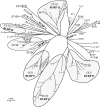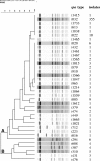spa Typing of Staphylococcus aureus as a frontline tool in epidemiological typing
- PMID: 18032612
- PMCID: PMC2238071
- DOI: 10.1128/JCM.01599-07
spa Typing of Staphylococcus aureus as a frontline tool in epidemiological typing
Abstract
We determined the value of spa typing in combination with BURP (based upon repeat pattern) grouping analysis as a frontline tool in the epidemiological typing of Staphylococcus aureus, based on a random collection of 1,459 clinical isolates sent to the German Reference Centre for Staphylococci within a 6-month period. The application was found to be helpful for the classification of isolates into the particular clonal lineages currently prevalent in Germany. Due to its major advantages because of the ease of interpretation and the exchangeability of the results, the use of spa typing greatly simplifies communication between laboratories on both the national and the international levels. Thus, it is an excellent tool for national and international surveillance of S. aureus as well as for analysis of the short-term local epidemiology. However, to overcome the limitations of the BURP grouping method in terms of typing accuracy and discriminatory power, the results of the default BURP grouping method must be interpreted with caution. Additional markers, like staphylococcal chromosomal cassette mec, lineage-specific genes, or alternative DNA polymorphisms, are indispensable. They should be selected by dependence on the clonal lineage indicated by spa typing and subsequent BURP analysis as well as on the basis of the particular question to be addressed.
Figures




References
-
- Aires de Sousa, M., and H. de Lencastre. 2004. Bridges from hospitals to the laboratory: genetic portraits of methicillin-resistant Staphylococcus aureus clones. FEMS Immunol. Med. Microbiol. 40101-111. - PubMed
-
- Aires de Sousa, M., K. Boye, H. de Lencastre, A. Deplano, M. C. Enright, J. Etienne, A. Friedrich, D. Harmsen, A. Holmes, X. W. Huijsdens, A. M. Kearns, A. Mellmann, H. Meugnier, J. K. Rasheed, E. Spalburg, B. Strommenger, M. J. Struelens, F. C. Tenover, J. Thomas, U. Vogel, H. Westh, J. Xu, and W. Witte. 2006. High interlaboratory reproducibility of DNA sequence-based typing of bacteria in a multicenter study. J. Clin. Microbiol. 44619-621. - PMC - PubMed
-
- Cookson, B. D., D. A. Robinson, A. B. Monk, S. Murchan, A. Deplano, R. de Ryck, M. J. Struelens, C. Scheel, V. Fussing, S. Salmenlinna, J. Vuopio-Varkila, C. Cuny, W. Witte, P. T. Tassios, N. J. Legakis, W. van Leeuwen, A. van Belkum, A. Vindel, J. Garaizar, S. Haeggman, B. Olsson-Liljequist, U. Ransjo, M. Muller-Premru, W. Hryniewicz, A. Rossney, B. O'Connell, B. D. Short, J. Thomas, S. O'Hanlon, and M. C. Enright. 2007. Evaluation of molecular typing methods in characterizing a European collection of epidemic methicillin-resistant Staphylococcus aureus strains: the HARMONY collection. J. Clin. Microbiol. 451830-1837. - PMC - PubMed
-
- Deurenberg, R. H., C. Vink, S. Kalenic, A. W. Friedrich, C. A. Bruggeman, and E. E. Stobberingh. 2007. The molecular evolution of methicillin-resistant Staphylococcus aureus. Clin. Microbiol. Infect. 13222-235. - PubMed
Publication types
MeSH terms
Substances
LinkOut - more resources
Full Text Sources
Medical

